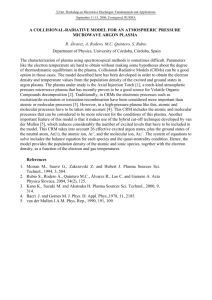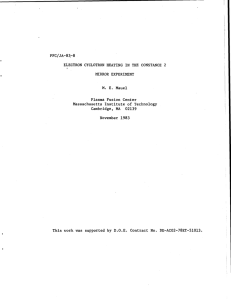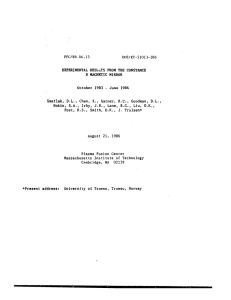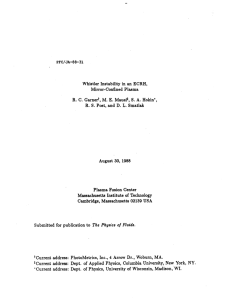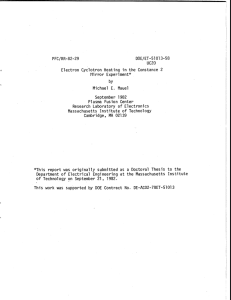PFC/RR-82-2 Description of the Fokker-Plank Code DOE/ET-51013-29
advertisement
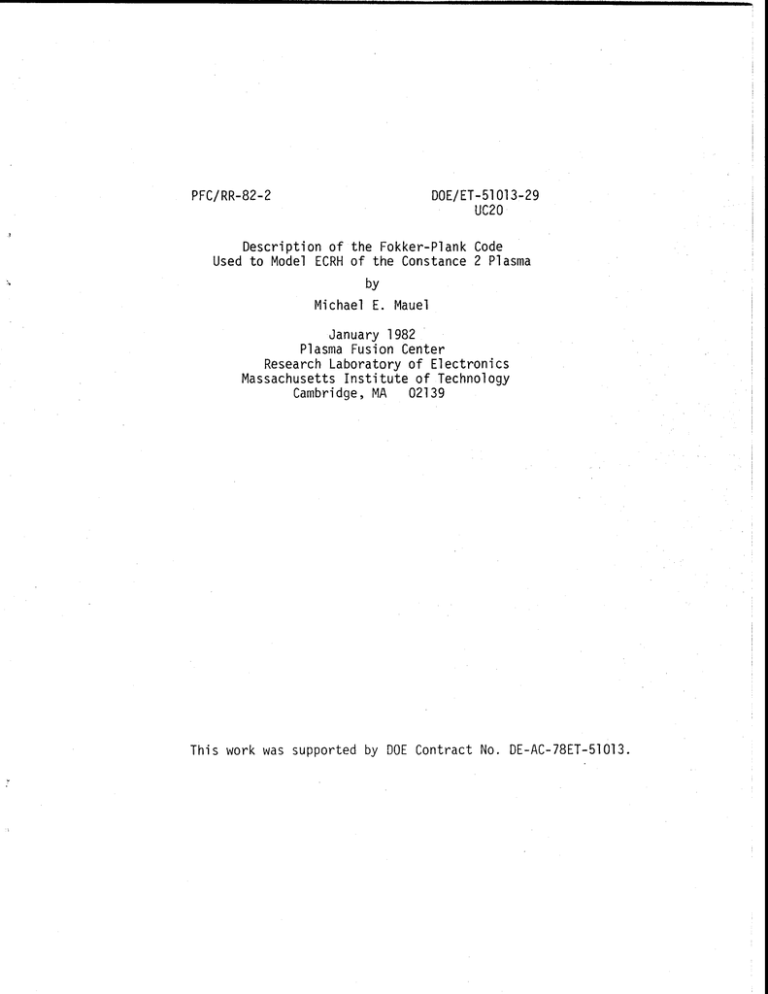
DOE/ET-51013-29
UC20
PFC/RR-82-2
Description of the Fokker-Plank Code
Used to Model ECRH of the Constance 2 Plasma
by
Michael E. Mauel
January 1982
Plasma Fusion Center
Research Laboratory of Electronics
Massachusetts Institute of Technology
02139
Cambridge, MA
This work was supported by DOE Contract No. DE-AC-78ET-51013.
Description of the Fokker-Plank Code
Used to Model ECRH of the Constance 2 Plasma.
by
Michael E. Mauel
January 30, 1982
Plasma Fusion Center
Research Laboratory of Electronics
Massachusetts Institute of Technology
PFC-RR-82/2
The time-dependent Fokker-Plank code which is used to model the development of the electron
velocity distribution during FCR H of the Constance 2 mirror-confined plasma is described in this report.
The ECRH is modeled by the bounce-averaged quasilinear theory derived by Mauel'. The effect of collisions are found by taking the appropriate gradients of the Rosenbluth potentials, and the electron distribution is advanced in time by using a modified alternating direction implicit (ADI) technique as explained
by Killeen and Marx 2 .The program was written in LISP to be run in the MACSYMA environment of the
MACSYM A Consortium's P1 )P- 10 computer.
I
This report describes both the timc-dependent, partial diffcrential equation used to describe the
development of the electron distribution during ECRH of the Constance 2 mirror-confined plasma and the
method by which this equation was solved. The electrons are modeled in (v; 0) phase-space, where 0 =
sin~-(vil/v). The ion distribution is considered to be a Maxwellian with known density and temperature.
'The ECRII is modeled with a bounce-averaged quasilinear equation which is strictly correct only for linear
heating of confined particles. However, since the magnetic field is assumed to be parabolic, the heating can
be txtended" into the loss cone when the potential is positive. Changes in the particle energy are assumed
:o occur randomly, over several passes through resonance. The potenti4l of the plasma is also assumed to be
parabolic and a known function of time. Those particles within the loss region of velocity-space are loss at
a rate detennined from their transit time. Each point in velocity space is advanced in time using a modified
Alternating Direction ImpIkit (ADI) technique used by Killeen and Marx2
The report is organized into six sections. The first section describes the Fokker-Plank model for
electron-electron and electron-ion collisions. The second section describes the loss-cone term from which
the electron loss current is calculated. The third section describes the programming of the ECRH term.
The fourth section describes the numerical method used to solve the part al-differential equation. The fifth
section lists the diagnostics available to evaluate the code's performance. And, the final section gives some
examples and checks of the operation of the program.
1. Collisions
1. 1. Rosenbluth Potentials . The electron-clectron and electron-ion collisions are given by the Rosenbluth
formulas,, or
2
FOKKER-PI.ANK CODE
8Fe(v)()= -Di(J~, + J'..)
where
J = [,,e(v)DIii3(v) - IDj(F(v)DiDtG,(v))
(2)
and where the potentials H3 and Gp satisfy Poisson's equation
V2H(v)
-
-4x
(3)
F,(v)
V2 GO(v) = 2''"HO(v)
(4)
Me
and I' = 4ne2e#Aep/m2. Mc,,L is the reduced mass, or mem,3/(m, + mi). Note that the derivatives, Di,
in Equations 1 and 2 are covariant derivatives. This insures the obvious result that the scaler formed from the
divergence of the vector Ji is invariant to changes in the description of the coordinate system. The integral
solutions to Equation 3 and 4 are
G(v) =
I
(=
dav'Iv
-
vFe(v')
(5)
dv' F"()
(6)
IMet)
f
V--V'l
As will be shown in the next subsection, only G,.l((v, 0) need be numerically integrated. Since for
each phase-space point, this integration involves a summation over all grid points and is very time consuming. Therefore, all of the coeflicients for the integration is saved on disk2 . Equation 5 can be expressed in
terms of the elliptic integral of the second kind, or
G,1(v,0) =
fo
v'2dvfo
sin 0'd'4Va'+ bE(a
where
a = v2 + v, 2 - 2vv'cosOcosO'
b = 2vv'sin0sinO'
d/2
E(mn) =
d 0/V -
mai in9
b
'(7)
3
COILISIONS
1.2. Reduction of the Fokker-Plank Equation . For this program, the electrons arc placed in a (v, 0, 0, 0)
coordinate system, and Equation 1 must be expressed in terms of these coordinates. The electrons are
assuned to be indepcndent of gyrophase, 0, and the collision term is trivially bounced-averaged over the
bounce-phase, V, by assuming a square-well. ('hc ECRI-l and endloss terms assume parabolic magnetic and
potential profiles.)
Equation 1 becomes
I~ ajj
- FeV2 H
()(9'H)
F
+ ~{(DiDjF)(DDiGg) +
2 (2Fe)(!V
2
)
V22GO
(8)
- ?H + I(DiD F )(D D G)
2
Mcm
(9)
or
-4FF-(1 - me
Me
(OFJ)(O
m
The electron and ion terms are therefore
I
F
41FrFe+ I(DiDjFe)(DD3Gele)
I OF,
r, ion
4rm,
Mi
(10)
(DlG,,
2
f ee Y
4 M+
"(I
-
1 f n)+
m /mi)(Fe)(O
(D D Fe)(DDiG .. )
(11)
me
The metric in the (v,0) coordinate system can be found by transforming the metric of spherical
coordinates to obtain
gij = vv+v
0# + O2sin20
2
p4
(12)
The most complicated term is the tensor formed from the covariant derivative of the velocity-space
gradient, which, in terms of ordinary partial derivatives, is
D,DjFe =
whec 1)
w0Cb
d
O
m
m
ineciwtof or (7hrivqffr/ ,.~'nbof) and is defincd fiom1 fihe Metric as
is ihcalioc
(13)
4
FOKKER-PIANK CODE
(14)
21j
Since Fe is independent of the gyrophase, then only tpe matrices r and Ie need be calculated. They are
lit,3
(15)
r?. = -vpp -vsin2O
(16)
+ I p; - sinOcos0*'
r=
This gives
D2 Fe
O2Fe
MFe
(17)
OVC90
VL90
0.
0
2
and the tensor product of the two double gradients become
(1/2)gikg (DjDjF )(DkDjG)= B ,j-+ 0c +
+-7D 3 + ' O2F
where
+cnB}
+ 2v
2B=
2
G +C
I (2-cos2Od92G
2C
+ cOi'
van
2C-=vsn
t 3Sino
Vj
002w-2sin0coO
2D=
o2 a
2E=
2F=2-2 { (12
+
1- X
+FC
(18)
5
COIJISIONS
For the ions, II and G are independent of pitch-anglc which allows an analytic expression for the
elcctron-ion collision term and simplifies the tensor tenn above.
1.3. The Electron-Ion Term . Although for clcctron-elcctror collisions, the potential, G,,i,(v, 0), must be
calculated from the evolving electron velocity distribution, the ions arc assumed to be Maxwellian. Their
potential can be calculated analytically.
Assuming,
Fio(V,0,.)
where vo 2 =
on/mi. Only, the terms
"io,ef"(v/vth02
7 3 / 2V'hi
0*9-h
OG2O,*Gaf
1 need
be calculated.
" can be found from Gauss's law
and Equation 3,
2
nG(V/Vh)
(19)
where
G
_-
erf(x)
2
(2/ 2 ijzzr
2X
and, likewise, for Gion
8Gio
2 M,
2
2 me f
2(v')v' dv'
vv2Me
0 I4 0 1
av
-
__2
3ut.IH 0 ,,(v
-+
o)
-*
Mf(,,,, I 1,1(V)
-I
f'
Sdv
aHq,,
13
20
20)
0, SO
H
o~v =-
d9I
nii)) rf(V/111hi)
(21)
6
FOKKER-PLANK COIE
Furthermore,
m2
2 vI
Z3 0(x)dz
V 32TIninofh =
-2Te
2Mcm
n
V2 {erf(v/v h)
(22)
3G(
which gives
-
On, 0{erf(vi/h)
=io
2n**" G(VlV)
(23)
-
and
*
Ov2
(24
(24
1.4. Summary of Collision Terms . The Fokker-Plank collision terms can, thus, be summarized as
e collisions
(A. + Aj )F +(B
(+
e +BeJK
+(Dee
(C
OFe
+ D,
+ Cc
F,,+
where
A=
Bee=
41rF.
I
62G
OG
2
p+
ctnOJ
tO
-1 f
C",=
09
2-
1I 2G
2 490
(&G +9G
I
E, =
W4
2?.
v J
I0
]f(92G
7- Cr ---
2v 2
.
V6~
'1
G
2sinO
(25)
2
+
cosB
F
2
OF,
25
7
COILISIONS
and
Bej
= n/rf(Vlhi)
G(v/va) 1+ 2(1 -Mj
-
)(V/qhi
Cei =2v3sinO {erf(v/vthi) - G(v/Vua)}
Dj = n
G(vfvhj)
Eei =
{e(Crf(V/qi)
-G(v/vtghd
1.5. A Simple Check . As a check of the formula, the function Pe(v,O) ~-v/1"h-? must be a stationary
solution to the Fokker-Plank collision operator. Ignoring the slower, electron-ion collisions,
47rv nF2 +
n {erf(x)
-G(z)}
+
- G(x)
(26)
But,
7 3/ 2V-'h
6F,
=
(922F,
8
(27)
2xFe
2F,+ 4x2F
-92
so that, when Equation 26 is substituted into Equation 25,
T, = Ti, the electron-ion tenn vanishes.
0. It is also easy to show that when
2. End Losses .
For particles in the loss-cone, the particle loss rate is given by
OF-
(7e
-
(28)
rra figit
B
FOKKER-PLANK CODE
where ma,,
is the time for a particle to go from the midplanc to the mirror-peak.
The loss-boundary is given by v (s = srp) = 0, or
= pBo+! V,
-
-
UO
(29)
or
V2
where Al = 4o -
V
-(1
A
mR)+
(30)
,,P, and R,, is the mirror ratio. In (v, 0) phase-space,
=
(31)
V2 >(2/m)A42
(32)
V2{ -Rsin29}
The condition of being within the loss-region is
1 -- Rlnsin p
for particles such that Isin.l < vfIR7,
and
V2 <2 (2q/m)Ab
- RmSin 2
(33)
for particles such that IsinBl > VIR7 . As can be seen, for positive 4, only the first inequality is used,
and for negative A, only the second is used.
The transit time is obtained from the equations of motion. Since
2
B(s)= B)(1 +
I(D)
44)(1 -
)
(34)
2
f2)
(35)
then
s(t) =
- sin (
Wil
t+
(36)
9
TIlE CRH TERM
where
2
-(p o + (q/m)AcI)
2
b
=
v 2 sin 2 o+LA!
(37)
mL(
L2
Therefore,
.ransi =
When wB < 0, then rans
this analysis.
WB
sin-
Lw(38)
(kcosO
~ sinh-1(Lwn/v cosO). Note that Yushmanov particles are not included in
Finally, a Maxwellian electron source is often added to the code to maintain the density constant,
balancing the loss cone term. When the source temperature is low (< 10ev), this acts to model a coldplasma stream or an entering flux of secondaries.
3. The ECRH Term
3. 1. The Diffusion Paths . The ECRI-I term used for this code was derived by MaucLi. In tlhis model, only
linear heating of trapped, electrons are heated. Since the effect of the heating is bounced-averaged, particles
in the loss region of velocity-space are not heated.
The bounce-averaged diffusion equation is
p)2 je.,
where aR
-
E-2
Drrsa F
(39)
is the square of the right-handed, electric acceleration, and
Ds, = (puw)Re{fl, } J (pk)
0x
---
rBt.,IL
+
-
(40)
(41)
(4E
10
FOKKIiR-PI.ANK CODE
For the program, two diffusion coefficients are defined. These are D, = E(pBaW)D,.e. and D2 =
E(pBwc)9D,./OX, which gives
= C2 DI
+ D2
(42)
The gradient along the diffusion path, 4/X, can be written in (v, p) coordinates by using the
identities
0
f(E, A,v, ) = E -- v2
. 2
g(E,/, v, 0) =Bo- v sino 0
(43)
and the appropriate Jacobians. For instance,
9(f, g)
tan20
4(E, v)
(44)
0(0, v)
and, likewise,
Op
v2 sincos0
(45)
(46)
av 0
00s
(47)
This gives the gradient along the difflusion paths as
0
where
(I(IR,.,
10
l
0
(
- sin27)/V2COSOs int. Also, after some algebra,
(48)
Ti Il'CRI TERM
1 02
02
Ox
2
0--
=
1 0
2
2
0'2±2
02
v0
a02
-0 + v
2cos2 -,1 +
sin0cosO
V2
M
11
(49)
The ECRIH tcrm can then be summarized as
I
OFe
a
IECRH
B+CEc)?,JI
(9F
aF
+
+ECRHZ
2F
2
0CR
+
RH-
a2F
+ 5h
02F
+FECRJI--FECII-a
(50)
where
BEcRjIj
CECIUI =
I
D2 - -Di
ID2 --
E
A 1
2cos2o
4
snCS
2
1
3.2.
EEC~IJ =
D2I
FECRH =
D
The Resonance Function . In this section, the rulcs used to evaluate D,
are explained. Since
pjk_ < 1,
if n = I
if n = 2
(51)
t/,,/2)
(52)
(whcre r;- = i/,'/2)
(53)
-- i
. 1,
Dre, = (pBpe resRe{f2,.1,2}
(1/4)A:2p2,
where
Refi
7
}
{7 WAeff
27rw/37-2Ai 2(u 1 ~
(where r--=
and where v, = w - nw, - k 1v11. I lore, all quantities arc evaluated at the point of rcsonance. Equation 51
is used for "simple" resonance points (e. when t1 , -+ 0 while t' remains finite): and Equation 52 is used for
"Airy" resonaiice points, which occur when both v." and, -+ 0.
FOKKER-PIANK CODE
~ii
WI'
-I---a---
-
-
*
*
A
~'
.,
*S
-
I
-
$
5-
~1~
'
S.
S.
-
-
= -
-
FAR FIW' IIIWSR
MIMi
ALMNMCL
mM IIRuing Milly
IMAN,
"I
-
I
/
I
,
-
-
-
-S
-
-
-S
-
hR
-
-
- -
-
*~
'
-
'
f
S.
5-
-
.-
RICh
Ru
Figure 1. Diagrams of the three classes of bounce-orbits used to detennine
the sum of the bounce-averaged, resonant wave-particle interactions.
The type and number of resonance points depend upon R,.., k1j, and the actual bounce-orbit of the
electron. For the program, these variations can be classified into three categories which are shown in Figure
1. The mirror is assumed to be symmetric for interchange of s with -s.
4. Numerical Methods
The Fokker-Plank equation (Equations 24, 27 and 38) is solved by the modified Alternating
Direction Implicit (AllD) method used by Killeen and Marx2 . A grid in the (v,0) phase space is defined
with variable spacing in the v-direction to provide a wide energy resolution and in the 0-direction to allow
quadrature integration. Typically, the grid has 45 v-points and 16-theta points. Integration in the v-direction
is performed with Simpson's nile modified to for variable grid spacing 2.
The ADI solution consists of kplitting" the 2-dimensional partial diffierential equation into two parts
so that the v and 0 differences can be taken separately. 'his gives two equations which can be solved
implicitly.
NUMIERICAL M1rIIODS
Fi+di/2 _ Ft
r S + AFC+dt/
2
FL+dt - Ft+dt/2
2
1
At
2
2
At
2
IFt +"'/
1
+
2
a2F
+d/
2
+ D - 2- -+-F"
e
I
82F1+dt
+ OfId
C_-_
1
2Fj +t/2
2v4
OtVOO
13
(54)
____+dt
S + AFe+u +C--C +
M +E
avF
2 +
+F
(55)
If, in each equation, central diffcrences are taken for each derivative (except for a backward derivative for
the mixed term), each equation can be written as
+ B"Fn + CnF n+
A"F'-
(56)
W
where, for the v-split
2i
V
rnj
1 F
2D
2v
-±
B
S!Ats+
V+'Av-
,EV-
_At(B+
V
I F
i ZOE.+A0
2D
At
E"-
AV
A
E v± 4 AOL
+
At
(F"-'
----
~-
4A0A-...
+t-
ATF
4AvAO+
(F"+11+1+F,"
IF
/+
F+
+1
~Fn
-
and, for the 0-split,
2E
At
AOC-+4
1
B
Ct- C
W
0
B?
EAtA
A
At
Av)
2AtE ( I
(
2E
i C+ +
+ YO-)
F
AV
AtF(Fn 1 1 1
F"1e+ 2IAtS + 'IAOAV.-
+
where
I-
I F
-- --( +
_+1+
-
F"+il
-F-
1+
1i
-
1+1)
14
FOKKER-PLANK CODE
I,
AvO = V"n+11V 1
v'n+' - vn'
-vp
n
= V1n+jl = V"' - V n- ,j
An
A0":.
and similarly for AO, Ao+, AOL. In the above equations, the index n refers to the v-direction and the index
I refers to the 0-axis.
Using boundary conditions, these difference equations define a tri-diagonal matrix which can be
easily transformed into upper triangular form. For example, the matrix defined in Equation 56 becomes
rI C
A
2
F
B2
C2
A3
B3
WI
W2
F
F
C3
3
-
AN-i
BN-1
N-1
CN-1
WN
F
N
A
(57)
which is equivalent to
I E,
1
E
2
F,
yl
F
y2
E3Py3
1F
(58)
1 EN-I
F
YN
-
e
where
E1=_C
En=
Y1
11Y"
Bn - AnE'n- 1
W
= wn-Ay-60)
B" - AE
(59)
(60)
After the coefficientsE" and Y" have been found, the solution is trivial:
yN
FN
F
-I
=
-
(01)
EXAMPLIES AND CICKS
15
The boundary conditions of the program are
1.
v=0,0=w/2
= 0 due to azimuthal symmetry.Fo" = F'.
2. F(n = N) = 0.
3. FO' is independent of I (ie. 0).
- 0 due to azimuthal symmetry.F.
4.
1
Fn
0 from bounce-direction symmetry.
5.
0=w/2
These boundary conditions are used to combine or eliminate terms in the upper left and bottom
right corners of the matrix. In this way, the initial conditions for the sweep out and back through the grid
indices are determined.
Finally, note that all of the gradients of Gt, (v, 0) needed for the electron-clectron collision term can
be found using ceatral differences since all of the boundary points are obtained implicitly from the interior
points and the boundary conditions.
5. Diagnostics
The following diagnostics are available to analyze the program's results during simulation of ECRH
of Constance 2: 1. F (v, 0), 2. F(E) and Fe(0), 3. (E)(t), 4. n,(t), 5. I188,(t), and 6. It0 ,(E).
6. Examples and Checks
Figure 2 shows an example of the relaxation of a non-Maxwellian electron population due to
electron-clectron collisions. Four contour plots of (Vi, V11) phase-space are shown for I = 0, 5, 10, and
20psec. The energy and density were constant to within 0.5%.
Figure 3 gives an example of the change in the average electron energy and total endloss when
FCRI I is applied. The ECRI I parameters were N = 2.0, IT3r= 10)/cn. and R,,, = 1.06. The density
the potential fixed at 25V. Ti,,, = 170ev, R, -= 2, and a cold electron
was fixed at 2.0 x 10"cmni.
7
= 0cOi) was added with a cUrrent eqimal to one-tenth the the total loss current. Figure 4
SOURC ( '.
show s the developiment of the electron energy distribution. and Figure 5 gives Four examnples of the resulting
16
FOKKUR-PLANK CODE
LLA--
Figure 2. The development of the electron distribution for a relaxing nonMaxwellian distribution due to electron-electron collisions. n. = 2.0 X
101 cm-3, and Te = 255eV. The density and energy remained constant
to within 0.5%. 20 equally-spaced contours were drawn for each plot.
ru
.1
k MA
Figure 3. lhe change of the averagc elcctron energy and the total endloss
with time. The run lasted 20pscc with the ICR H 10pscc long. Many
features of the run are similiar to those observed in the experiment, such
as the enhanced endlosses, the "ECRH equilibrium". the non-maxwellian
energy distribution, and the energy distribution of thc endloss.
17
EXAMPlES AND CHECKS
IT
T . 0.0
12.0
.
S.
T=20.0
-
v.
w
Figure 4. Thc change in the electron energy distribution due to ECRH.
w/wco = 1.06, |E,. = 10.0V/cm, and Nji = 2.0. For t = 0, 4.5, 12,
and psec.
T
T - 4.5
0.0
-.
T
*
12.0
1igure 5. The electron phase-space corresponding to the four timelCS shown
in Figure 4.
.-
.
T
*
20.0
.
velocity-space distribution as the run progressed. Many features of the run arc similiar to those observed
in the experiment, such as the enhanced endlosses. the "ECRIH equilibrium", the non-fnaxwellian energy
distribution, and the energy distribution of the endloss.
References
1. Mauel, M. E.,Theory of Electron Cycloron Heating in the Constance I Experiment, PFC-RR-81/2,
Massachusetts Institute of Technology, (1981).
2. Killeen, J. and K. D. Marx, "The solution of the Fokkcr-Plank Equation for a Mirror-Confined
Plasma," Advances in Plasma Physics, Vol. ?, (19??), 421-489.
3. Cutler, T. A., L. 1). Pearlstein and M. E. Rensink,Computationof /he Bounce-Average Code, UCRL52233, LLL, (1977).
4. Rosenbluth, M. N., W. M. MacDonald, and D. L. Judd,"Fokker-Plank Equation for an inverse-Square
Force.," PhysicalReview. 107, (1957), 1-6.
5. Weinberg, S., Gravitationand Cosmology, Wiley, New York, (1972), 91-120.
6. Hornbeck, R. W., NumericalMethods, Quantum, New York, (1975).
I
PFC BASE LIST
INTERNAL MAILINGS (MIT)
G. Bekefi
36-213
R.R. Parker
NWl 6-288
A. Bers
38-260
N.T. Pierce
NW16-186
D. Cohn
NW16-250
P. Politzer
NW1 6-286
B. Coppi
26-201
M. Porkolab
36-293
R.C. Davidson
NW16-202
R. Post
NW21 -
T. Dupree
H. Praddaude
NW14-3101
38-172
S. Foner
NW14-3117
D. Rose
J. Freidberg
J.C. Rose
38-160
NW16-189
A. Gondhalekar
NW16-278
R.M. Rose
4-132
M.O. Hoenig
NW16-176
B.B. Schwartz
M. Kazimi
NW1 2-209
R.F. Post
NW21-203
L. Lidsky
38-174
L.D. Smullin
38-294
E. Marmar
NW16-280
R. Temkin
NW16-254
J. McCune
31-265
N. Todreas
NW13-202
J. Meyer
24-208
J.E.C. Williams
NW14-3210
D.B. Montgomery
NW16-140
P. Wolff
36-419
J. Moses
T.-F. Yang
NE43-514
NW16-164
D. Pappas
NW1 6-272
Industrial Liaison Office
ATTN: Susan Shansky
24-210
NW14-5121
Monthly List of Publications
39-513
MIT Libraries
Collection Development
ATTN: MIT Reports
14E-210
B. Colby
PFC Library
NW16-255
EXTERNAL MAILINGS
National
Argonne National Laboratory
Argonne, IL
60439
ATTN: Library Services Dept.
Dr. D. Overskei
General Atomic Co.
P.O. Box 81608
San Diego, CA
92138
Battelle-Pacific Northwest Laboratory
P.O. Box 99
Richland, WA
99352
ATTN: Technical Information Center
Princeton Plasma Physics Laboratory
Princeton University
P.O. Box 451
Princeton, NJ
08540
ATTN: Library
Brookhaven National Laboratory
Upton, NY
11973
ATTN: Research Library
Plasma Dynamics Laboratory
Jonsson Engineering Center
Rensselaer Polytechnic Institute
Troy, NY
12181
ATTN: Ms. R. Reep
U.S. Dept. of Energy
20545
Washington, D.C.
ATTN: D.O.E. Library
Roger Derby
Oak Ridge National Lab.
ETF Design Center
Bldg. 9204-1
37830
Oak Ridge, TN
General Atomic Co.
P.O. Box 81608
92138
San Diego, CA
ATTN: Library
Lawrence Berkeley Laboratory
1 Cyclotron Rd.
Berkeley, CA
94720
ATTN: Library
Lawrence Livermore Laboratory
UCLA
P.O. Box 808
Livermore, CA
94550
Oak Ridge National Laboratory
Fusion Energy Div. Library
Bldg. 9201-2, ms/5
P.O. Box "Y"
37830
Oak Ridge, TN
University of Wisconsin
Nuclear Engineering Dept.
1500 Johnson Drive
Madison, WI
53706
ATTN: UV Fusion Library
EXTERNAL MAILINGS
International
Professor M.H. Brennan
Willis Plasma Physics Dept.
School of Physics
University of Sydney
N.S.W. 2006, Australia
The Librarian (Miss DePalo)
Associazione EURATOM - CNEN Fusione
C.P. 65-00044 Frascati (Rome)
Italy
Division of Plasma Physics
Institute of Theoretical Physics
University of Innsbruck
A-6020 Innsbruck
Austria
Librarian
Research Information Center
Institute of Plasma Physics
Nagoya University
Nagoya, 464
Japan
c/o Physics Section
International Atomic Energy Agency
Wagramerstrasse 5
P.O. Box 100
A-1400 Vienna, Austria
Dr. A.J. Hazen
South African Atomic Energy Board
Private Bag X256
Pretoria 0001
South Africa
Laboratoire de Physique des Plasmas
c/o H.W.H. Van Andel
Dept. de Physique
Universite de Montreal
C.P. 6128
Montreal, Que H3C 3J7
Canada
Plasma Physics Laboratory
Dept. of Physics
University of Saskatchewan
S7N OWO
Saskatoon, Sask., Canada
The Library
Institute of Physics
Chinese Academy of Sciences
Beijing, China
Mrs. A. Wolff-Degives
Kernforschungsanlage Julich GmbH
Zentralbibliothek - Exchange Section
D-5170 Julich - Postfach 1913
Federal Republic of Germany
Preprint Library
Central Research Institute for Physics
H-1525 Budapest, P.O. Box 49
Hungary
Plasma Physics Dept.
Israel Atomic Energy Commission
Soreq Nuclear Research Center
Yavne 70600
Israel


